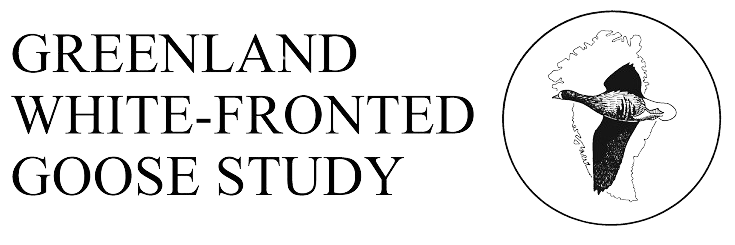1. The Greenland White-fronted Goose Anser albifrons flavirostris is the most distinct sub-species of the circumpolar White fronted Goose Anser albifrons. It breeds in west Greenland and migrates through Iceland to winter exclusively in Britain and Ireland, where it remains one of the rarest of wintering goose populations.
2. The population declined from 17,500-23,000 in the 1950s to 14,300-16,600 in the late 1970s and as a result of conservation concerns at the time, the population was protected from hunting and many of the sites supporting internationally important concentrations were given statutory protection.
3. Under these protection measures, and helped by a series of good breeding seasons, the population increased from 17,000 in 1982/3 to 35,500 in 1998/9. However, in the subsequent years, numbers have fallen dramatically to less than 27,000 in 2001/2, a 25% decline in 3 years.
4. Because the population is closed, and the annual population census covers all known wintering resorts, the change cannot be the result of changes in immigration or emigration, and must result from changes in birth or death rates.
5. Evidence from survival estimates based on resightings of collared individuals suggest no major changes since protection in 1982/3, supported by the results of population modelling based on counts at the two major resorts, Islay (Inner Hebrides, Scotland) and Wexford (southeast Ireland).
6. The proportion of young returning to winter at Islay and Wexford shows declining trends since protection. Evidence from detailed observations of collared birds at Wexford shows that known aged birds are showing a delay in the age of first breeding, and that an increasingly small proportion (<5%) of all goslings surviving their first winter survive to ever breed at all.
7. Simple mathematics shows that the decline in number is simply due to the failure of the reproductive potential of the population to replace annual losses, the latter of which have not changed substantially over a period of decades. The decline is explained by the sustained decline in reproductive output, not due to any increase in mortality, although the causes for this long-term decline remain unknown.
8. At least three potential (not necessarily mutually exclusive) explanations have been offered for the decline in reproductive success of Greenland White-fronted Geese since 1982/3. These are increases in overall population density, reductions in summer temperatures in the north of their breeding range (a factor known to depress breeding success) and competition with Canada Geese, which have newly colonised west Greenland from northern Canada. Other (currently unknown) factors may also be involved.
9. Studies of interactions between the two species on the summer areas show the behavioural dominance of Canada Geese, at least during the flightless moult, which results in local displacement of White-fronted Geese. However, more extensive survey is required to determine whether this is the major factor involved in depressing breeding success in Greenland White-fronted Geese.
10. Greenland White-fronted Geese remain a quarry species in Greenland (where a few hundred are thought killed each year because of their inaccessibility) and in Iceland, where the bag has shown a significant increase during 1995-2001. This increase, coincident with the decline in global population size, means that the Iceland hunting kill has risen from 8% to 12% at present, and now contributes a significant, and increasing, element of overall annual mortality.
11. Whilst it is clear that the autumn hunt in Iceland was sustainable during the period of population expansion of the 1980s and 1990s, the present level of kill cannot assist in returning the population to favourable conservation status. While the cessation of the autumn hunt there cannot halt the current decline in the overall population, it is one tangible conservation action that will contribute to the slowing of the rate of decrease in numbers.
12. It is important that the management plan, drafted and agreed for this population in Wexford, Ireland in 1992 but never formally signed by the range states (Ireland, United Kingdom, Iceland and Greenland), be reconvened and updated, to establish research and monitoring priorities for action. Actions must be targeted to secure the population for the future to ensure that the international investment in the protection of the population that occurred in the 1980s and 1990s was not in vain.

